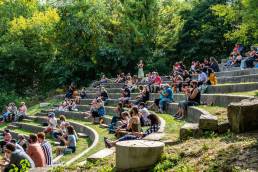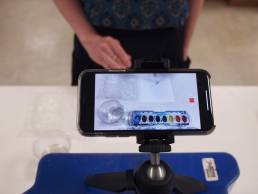By: Chris Hampton
Although the calendar is fresh — the first month of a new year — we seem to count time differently these days. To most of us, it is month No. 10. Ten months since work-from-home began, 10 months since schools first closed and 10 months since normal life was otherwise interrupted. For cultural organizations across the province, it’s now 10 months since public health restrictions shut their doors.
Some — such as museums and libraries — have been able to re-open and modify to safely serve visitors. Others, like many in the performing arts, have not yet been able to open and have instead had to learn how to operate with their doors remaining closed. For every organization, surfing the waves of the pandemic has meant learning new flexibility and responsiveness in a situation that can change both quickly and dramatically.
With a vaccine now rolling out in Ontario, light has thankfully appeared on the horizon. There’s a chance you might be applauding a curtain call or crowd-surfing again before the year is out. But some tricky months lie ahead. Ontario is back under lockdown.
So how are arts groups coping? Ontario Culture Days reached out to four organizations in the Greater Golden Horseshoe, where regulations have been tightest, to see what it means to present cultural programming through a pandemic.
The challenges are considerable. But for many, the important roles they play within their community have been made clear. Some have even found that within a crisis, there are opportunities, too.

Canadian Stage
“We’re getting pretty good at pivoting,” says Canadian Stage executive director Monica Esteves. “The joke around here is that soon, we’re going to be dancers ourselves.”
When the not-for-profit contemporary theatre and dance company — one of Canada’s largest — closed its venue doors in March, it cancelled the next five months of regular programming. Though indoor audiences might be a no-go in heavily-restricted Toronto, the organization identified three types of activities (Invest, Explore, and Engage) it could undertake to meet the challenges and opportunities presented by COVID-19.
Under the first stream, Invest, Canadian Stage is focusing significant funds to help theatre- and dance-makers experiment with and/or shift their artistic practices through a series of $2,000 microgrants as well as scholarships for technicians and designers wishing to upgrade skills.
The Explore stream offers support for investigation into new forms of performance, and includes, for example, a residency in partnership with the University of Toronto’s BMO Lab focused on the applications of AI, augmented reality and virtual reality in dramatic arts.
And the third stream, Engage, is about bringing unique experiences to audiences. For Canadian Stage, that includes digital productions, as well as outdoor performances like Dance in High Park, and panels and public think tanks that are delivered virtually. One hit was an interactive experience by New York’s 600 Highwaymen, titled A Thousand Ways. The telephone drama performed for just two audience members at a time quickly sold out a few hundred performances. The second part of the group’s trilogy with Canadian Stage will debut later this year.
“I’m loathe to use the word ‘downtime,’” Esteves says, “because I feel like I’ve never been busier, but we are using the moment as an opportunity to seed new ideas and projects for the future. We’ve increased our commissioning budget by three [times].”
Halton Hills Public Library
Within a week of the March lockdown, the Halton Hills Public Library had its first storytime online. Now, 99 per cent of its programming happens virtually, says marketing and communications specialist Dennis Roberts. The popular “Drag Storytime” series? Online. Intro to 3D printing classes? Also online. Ditto its summer reading program.
Just as important, however, is that what’s not accessible online can still be easily accessed. Of course, there’s curbside pickup, but HHPL’s Home Library Service actually offers contactless delivery and retrieval of loanable materials. Children’s activity sessions have transformed into handy grab and go kits. (One week, it’s a themed craft, says Roberts, the next it’s a letter for Santa project.) And in April, HHPL launched the Library Connect Line, which provides isolated patrons with regular phone calls to discuss authors, offer referrals to service providers and assist with technology. The calls average 30 minutes and many Connect Line users access the service once or twice a week.
“We strive to improve people’s lives by helping to bridge the gap between the haves and the have nots, especially when it comes to literacy and computer skills training,” Roberts says. “We are a vital social service, ensuring that knowledge and technology are available to everyone.”

Kitchener-Waterloo Art Gallery
When disruption and delay have become the norm, it’s something of a miracle that the Kitchener-Waterloo Art Gallery pulled off its full 2020 exhibition calendar very nearly uninterrupted. There are certain advantages to being a smaller, more nimble operation.
After the gallery closed in mid-March, workshops, educational resources, children’s activities, panel talks, and film screenings migrated online. Meanwhile, a pair of installers stayed behind to continue work on its next planned exhibition. When the gallery re-opened in June 2020, visitors — 10 at a time — were treated to the new exhibition, Soundings, featuring artworks by Indigenous artists that function as musical scores. The show included performances held outdoors, which drew as many as 100 people to each. Other artworks, like a piece comprised of beads by Olivia Whetung or the headphones at video stations, required visitors to touch; the gallery was only able to present these by diligent monitoring and a rigorous sanitization protocol between uses.
In September, KWAG debuted a much-anticipated solo exhibition by the Toronto-based multidisciplinary artist Deanna Bowen — also on schedule.
The gallery has found some success with this hybrid programming model — part online, part in-person. The average artist talk, for example, draws about 30 people to KWAG’s Queen St. space, whereas a recent talk with Bowen garnered a couple hundred viewers virtually, says media and communications manager Stephanie Vegh.
KWAG is keen to sustain high-caliber online programming even “after the pandemic is a distant memory,” Vegh says. And so is the community, it seems. A fundraiser to support the gallery’s digital capacity quickly surpassed its $30,000 goal.
“I think the value of what we do is appreciated here,” Vegh says. “And I think there’s possibly an even stronger awareness of who we are and what we do in this community that’s come about because of how much more online we’ve had to be.”
Koerner Hall
In a regular year, Koerner Hall, the largest of three concert venues in The Royal Conservatory of Music’s building in Toronto, hosts about 300 shows. “It’s probably one of the busiest halls in Canada,” says executive director of performing arts Mervon Mehta. “We do everything from classical orchestral to chamber music, a lot of jazz, a lot of world music, some pop, some singer-songwriters.”
Of course, this year has been different. After cancelling and postponing months of programming, Koerner Hall got the go-ahead to stage its first pandemic-era concerts with a live audience in September. Though the venue could safely accommodate over 300 physically-distanced concertgoers (in a concert hall of 1,135 seats), Mehta says, it was permitted to welcome an audience of 50.
Musicians playing there wear masks on stage. There’s Plexiglas between every woodwind player and every brass player and in front of every singer, Mehta explains. “It’s not the way any of us want to do music, but it’s what we have to do for the time being.”
During September and October, hosted performances by jazz pianist and vocalist Fern Lindzon, sitarist Anwar Khurshid and the Songwriters Association of Canada, among others. Audience members were in tears, Mehta says. “They were thanking us; they were thanking the artists. They said they couldn’t wait to come back.”
Then, the week of Oct. 18, when pianist Angela Hewitt was scheduled to perform a sold-out concert, the venue was once again ordered closed to the public. But Koerner Hall had resolved that the show must go on and streamed Hewitt’s concert online privately for over 700 people who’d originally bought tickets . “We decided not to stick our heads in the sand and wait it out,” Mehta says. “Artists need to work, our crews need to work. It’s their livelihood.”
Koerner Hall has live-streamed every performance since, including a Beethoven festival in December, celebrating the composer’s 250th birthday. Attendance has actually been quite remarkable: between 600 and 1,200 ticketed viewers per concert and many more for their free livestreams.
The popular 21C Music Festival will still take place next, launching Jan. 16. Instead of a packed hall, artists will perform to Mehta, his small production team and 1,100-some empty seats. For the time being, their audience isn’t in the house, but they are watching and listening at home.
Chris Hampton is an arts and culture writer based in Hamilton. His work has appeared in Canadian Art, The Walrus, The Globe and Mail, Toronto Star, CBC Arts and The New York Times.
